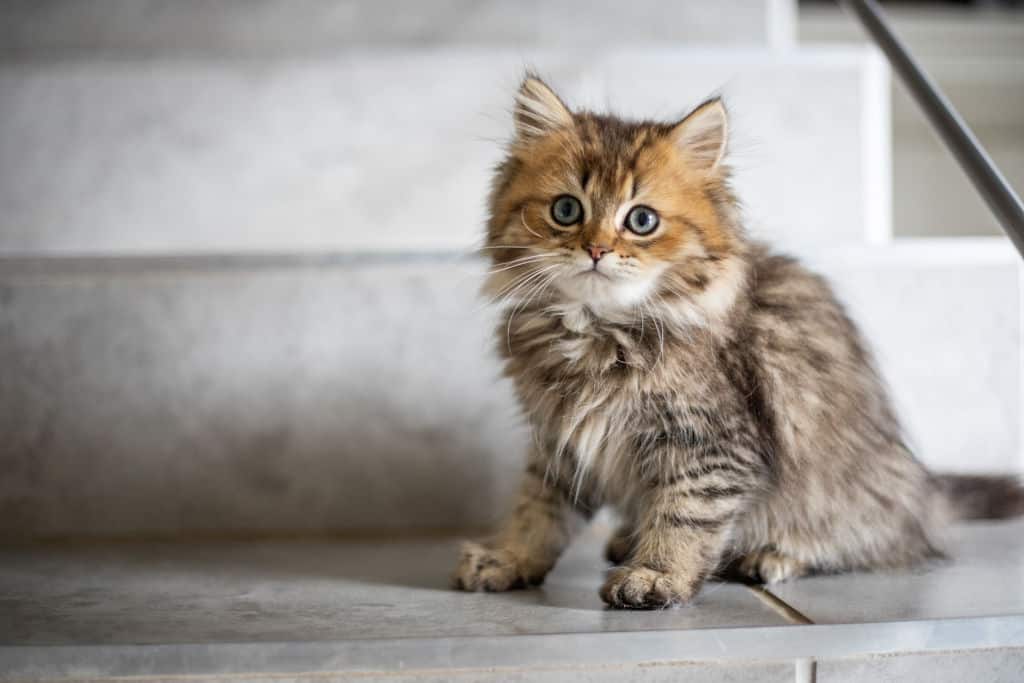Disclosure: We may earn a commission from helpful, relevant links in our content. No cost to you. See our privacy policy.
Some kittens will drive you crazy, while others are the cuddliest creatures ever. While most kittens are playful and friendly, some can be quite unpleasant. Why is this?
This article explores the reasons for a kitten’s unfriendliness, whether it’s normal to dislike you, and how to win over and socialize an unfriendly kitten.

What Makes a Kitten Not Friendly?
A kitten may be unfriendly for various reasons, including:
- Lack of socialization. Kittens that haven’t been properly socialized with people and other animals during their critical socialization period may be fearful and avoid human interaction.
- Poor previous environment. If a kitten has been in an overcrowded or competitive setting, it may exhibit a more defensive stance initially, making it seem less friendly.
- Trauma or abuse. Kittens who have been physically or emotionally abused may be distrustful of humans. Assisting young kittens in overcoming their phobias may require time, patience, and positive reinforcement.
- Health issues. Kittens in pain or discomfort due to a health problem may be less friendly and avoid interaction. Addressing the underlying medical issue can help improve the kitten’s overall demeanor and willingness to interact with people.
- Genetics. Some cats are naturally more independent and aloof than others. This doesn’t mean they can’t form strong bonds with people, but it may take longer and require a different approach to socialization.
- Fear. Kittens may become fearful of people if they have had a negative experience, such as being yelled at or hit. Building trust and positive associations with the kitten through treats, play, and affection can help overcome their fear and increase their comfort level around people.
The first step in helping a kitten become more friendly is to provide a safe and supportive environment and approach the kitten slowly and gently. You can then build this trust further with the right approach and tools.
Is It Normal for a Kitten to Dislike You?
Many apprehensive and unsocial cats I’ve known have warmed up to their homes and families after years of living there. Cats can be slow to warm up, but even the most fearful cats can become friendly over time.
One pivotal factor is consistency. When a kitten realizes that positive experiences with humans are regular and not just one-off events, its trust deepens, paving the way for a stronger bond.
So yes, it’s normal for a kitten to dislike someone, especially if they’ve had bad experiences or haven’t been properly socialized. Kittens, like other animals, have distinct personalities, and some may be more cautious or aloof by nature than others.
Cats, unlike many other pets, operate on their timelines. They aren’t overtly eager to please like dogs, so when a kitten seems unfriendly, it’s usually acting out of instinct or past experiences rather than spite.
Approach a kitten that appears to dislike you carefully and softly, allowing them to come to you on their own terms.
Kittens, especially stray or feral cats, need time to warm up to their new owners or homes. Cats, unlike dogs, require time to trust and build bonds with their owners.
Remember that a kitten’s independence doesn’t reflect its affection for you. An unfriendly demeanor might just be a mask hiding a genuinely loving and loyal companion.
It is possible to socialize with an unfriendly kitten by introducing the kitten to pleasant interactions with people, other animals, and new locations. It also involves encouraging play, reinforcing positive behavior, and other activities that might help them become more confident and comfortable.
The owner’s personality traits may determine the personality qualities of the cat. How friendly they become will be determined by how much time you spend playing with them and whether or not they have been or will be abused. You can lure even the most unfriendly cats into cuddling with you.

How Do You Win Over an Unpleasant Kitten?
Winning over an unpleasant kitten may take more time and patience than socializing a more confident kitten, but you can do it with the right approach. Here are some tips you can do to win over an unpleasant kitten:
1. Start Slow
When approaching the kitten, it is essential to move slowly and calmly. Avoid forcing interaction or handling the kitten too much. Instead, let the kitten come to you on its own terms. This will help build trust, reduce stress, and allow the kitten to stop hiding.
2. Create a Safe Space
Providing a quiet and comfortable space for the kitten to retreat is vital for their overall well-being. This space should be a sanctuary where the kitten can feel safe and secure, away from potential stressors.
3. Provide extra litter boxes
Ensure there are enough litter boxes for the kitten to use. Add one extra litter box to encourage elimination. Place them near the kitten’s favorite spots to encourage usage. Refrain from placing them near the food, and try to clean the boxes regularly, if not twice a day.
4. Provide scratching posts
Place scratching posts to encourage appropriate scratching behavior. Offer different orientations and materials to cater to the kitten’s preferences.
Try to place the scratching post near objects that the kitten may be attracted to scratch, such as curtains, wallpapers, or furniture, as this makes it more likely that the kitten will use the post instead of other items in the environment.
5. Place rocks over the soil to protect houseplants
First, it helps prevent the kitten from digging in the soil, which can be damaging to houseplants. Additionally, placing rocks over the soil can help prevent the kitten from eliminating in inappropriate areas, such as on or near houseplants.
This way, you can create a barrier that makes it more difficult for the kitten to dig, which is a common issue with kittens who are not properly trained or used to using a litter box. By providing a less appealing surface for elimination, you can encourage the kitten to use a litter box instead.
6. Use PetSafe SSSCAT Spray Deterrent
Place SSScat near closed doors to deter the kitten from entering restricted areas. You can also use an airhorn as a deterrent, but make sure the kitten does not see you when it happens. At least do not talk while you’re doing it, so the kitten doesn’t associate you with the horn.
PetSafe SSSCAT Spray Deterrent is a good solution for managing destructive or unwanted behaviors in kittens because it is humane and safe yet effective. The spray emits a short burst of air when it detects movement, which startles the kitten and discourages them from continuing the behavior.
7. Provide high places
Cats like high places, so try dedicating shelves for the kitten to lounge on. However, remove anything valuable until the kitten calms down and gets out of its kittenhood.
Providing high places for kittens is effective because cats naturally seek elevated spaces for safety and security. Offering high places, such as shelves or cat trees, can help satisfy the kitten’s instinct to climb and explore, improving their physical and mental well-being and reducing stress and boredom.
8. Encourage interactive play
Ensure the kitten gets at least 30 minutes of interactive playtime a day, using toys such as wand toys, and feed the kitten after playtime to help burn off excess energy.
Get a string toy on a stick. Use the toy to play a bit when the kitten is near you. Not all cats like toys, but this is one of the favorites of many kittens I’ve raised.
9. Reinforce positive behavior
Reinforce positive behaviors by offering treats and affection, and redirect destructive behavior with toys or other positive alternatives. Treats can be a powerful tool in helping the kitten to feel more relaxed and comfortable in their new environment.
10. Use “remote correction” of behavior.
If the kitten attacks you, you must firmly make it clear that behavior isn’t acceptable. What works varies from cat to cat, but some things to try are part of the “remote correction.”
Punishment with spray bottles, compressed air containers, and time-out sessions in bathrooms will likely not work. Punishment does not work well on cats, so you need a different approach that helps socialize your cat and removes you as the bad guy.
For example, blow a whistle or shake a penny can (a can filled with pennies) as soon as the kitten is about to engage in destructive behavior. These will simply startle a cat but will not terrify it. Then, do something to promote better behavior after that.
Following these tips can help an unfriendly and destructive kitten become more confident, socialized, and well-behaved.
FAQs
How long does it take for a kitten to become friendly?
The time it takes for a kitten to become friendly varies based on their personality and previous experiences. A kitten can become comfortable and pleasant with its surroundings and people after several weeks to several months of continued socialization and positive reinforcement.
How do you calm down an aggressive kitten?
To calm down an aggressive kitten, avoid punishing the kitten and try to provide a calm and quiet environment. Provide plenty of playtime and positive reinforcement for non-aggressive behavior, and seek professional treatment if the behavior does not change.
Do kittens only bond with one person?
Kittens can build bonds with many people rather than just one. However, they may prefer particular people based on their behavior and the time spent with the kitten. A kitten can grow friendly and bond with several individuals with sufficient socialization and reinforcement.
Alex, a passionate animal lover, has experience in training and understanding animal behavior. As a proud pet parent to two dogs and three cats, he founded AnimalReport.net to share insights from animal experts and expand his knowledge of the animal kingdom.




